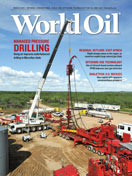Issue: March 2015
Special Focus
A newly developed, ruggedized air-drilling system increased rig up time, reduced costs for mud and cuttings disposal, improved hole cleaning, and increased ROP.
Features
Coiled tubing (CT) drilling offers an economical alternative to conventional, jointed pipe drilling when accessing mature and low-yield fields. A 40% reduction in cost can be achieved by CT’s ability to drill continuously, mobilize faster, reduce rig time, and require fewer preparations.
Part 1: In this first of two installments, the latest developments in well logging and formation evaluation are assessed. General developments include ongoing efforts to improve the accuracy of the logging depth measurement and wellbore position, improving standards for well-log deliverables, and multi-log correlation. New developments in LWD, openhole wireline, and sensor design and methodology are discussed in detail.
Terra Nova oil field is an offshore production zone in eastern Canada, using North America’s first FPSO vessel. When hydrogen sulfide was found in its producing oil wells during 2010, the namesake FPSO underwent a complete decommissioning and upgrading of its gas detection system.
Capital shift squeezes unconventional prospects
Energy development will bring economic progress to the emerging nations of East Africa
Columns
Of bulbs and bubbling crude
Teapot Dome’s ghost banished?
To oil, or not to oil (and gas), that is the question
Oh, by the way
Repeal the export ban? Price drop puts a new twist in the debate
“Operation Car Wash” takes shine off Petrobras
Southeast Asian nations develop “coping strategies” for oil price downturn
The mainstreaming of MPD
The Sniffers: Detection dogs
Splinters in the windmills of Putin’s mind
News & Resources
World of oil and gas
Industry at a glance
People in the industry
New products and services
Companies in the news
ShaleTech Report
Technical gains continue, in spite of prices
During the hectic shale boom, there was little time for formation evaluation. The focus was on drilling, fracturing and getting wells online as quickly as possible. With lower oil prices and slashed capital budgets, companies should take time to think about how to survive, and even thrive, in the new reality.
Shale gas has proven its worthiness through a revolution of E&P activity over the last decade, particularly in the U.S. Yet, the question remains, can it prevail beyond current, low commodity prices, as well as environmental/public controversies, specifically in Europe?
An integrated analysis of fracture interference revealed that hydraulic fracture system damage was, most likely, due to stimulation fluid flooding, into depleted fracture systems around parent wells, resulting in a reduction in the effective fracture area. The team proposed a number of options to mitigate the impact of fracture interference, including refracturing the existing producing well with an energized fluid.
With lower oil prices, unconventional plays require a high degree of efficiency to become profitable. The highest number of wells should be drilled with the fewest rigs and services, at the fastest possible rate. Three new positive displacement motors were developed for specific applications in the Williston and Niobrara basins. This focused engineering has delivered enormous savings to operators.
After detailed analysis of shale well designs and drilling operations in the Bakken, a new drill pipe was introduced to reduce the wear on the pipe body while drilling the intermediate 8¾-in. hole section, as well as providing adequate annular clearance between the pipe and the wellbore to keep the ECDs in check.
The result of a 14-month design and laboratory qualification work, a new, composite frac plug provides superior sealing strength and allows fast mill-out with fewer large cuttings.
Originally introduced to the E&P industry more than 30 years ago, silica gel, in its next-generation version, is now finally gaining widespread acceptance as a frac fluid viscosifier.
Whatever the E&P implications of current market conditions might be, now is not the time for operators to disengage from the legislative and administrative processes that will continue to affect hydraulic fracturing operations, long after present conditions subside.
This study examined 46 wells in AWP field in McMullen County, Texas, over a 10-year time frame. The authors compared 23 wells using 100% frac sand, and 23 wells utilizing a curable resin-coated proppant tail-in. The study concluded that there is a positive net present value when using curable resin-coated proppant tail-in to control frac sand flowback.
What’s new in Shale technology



